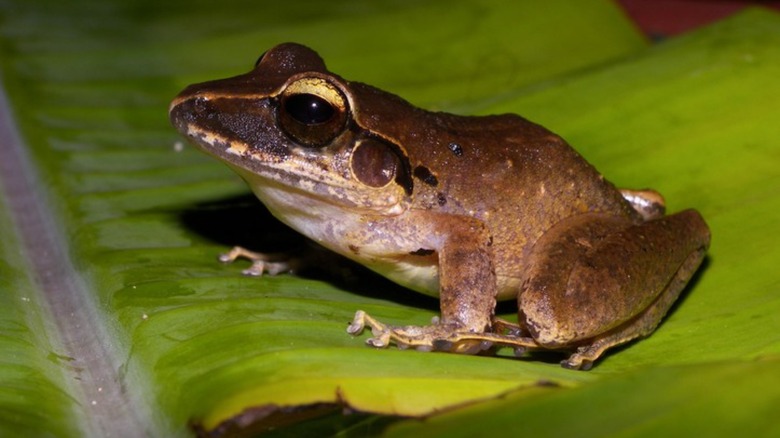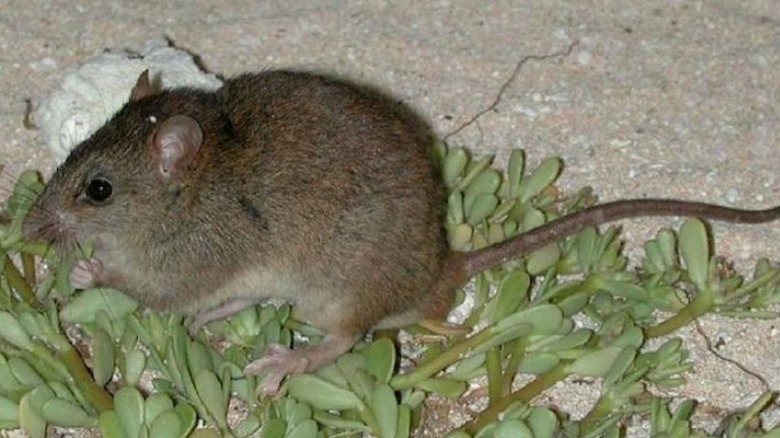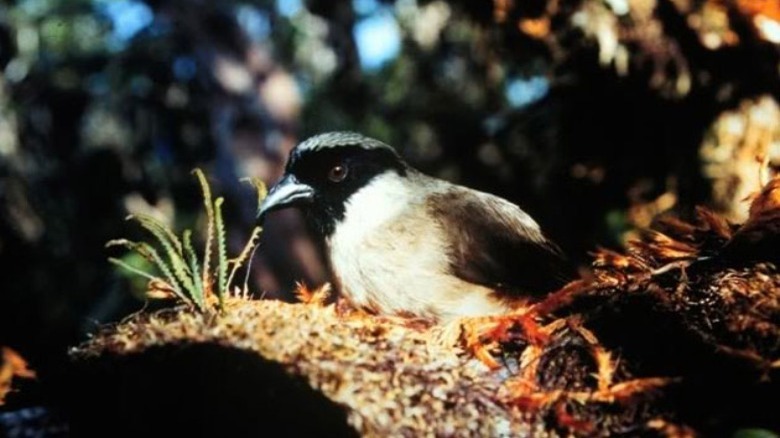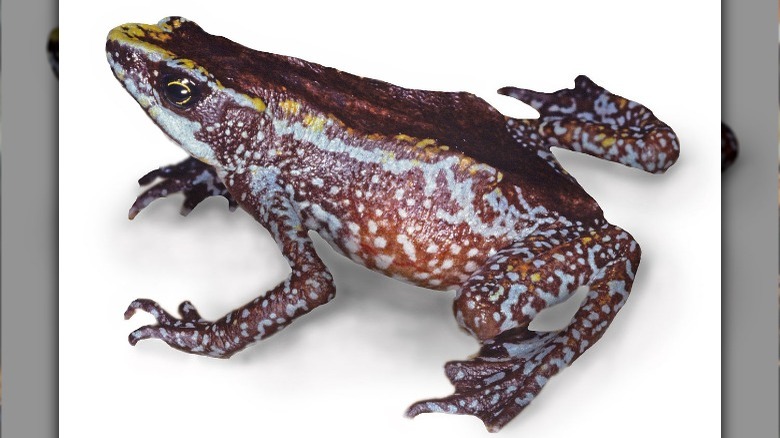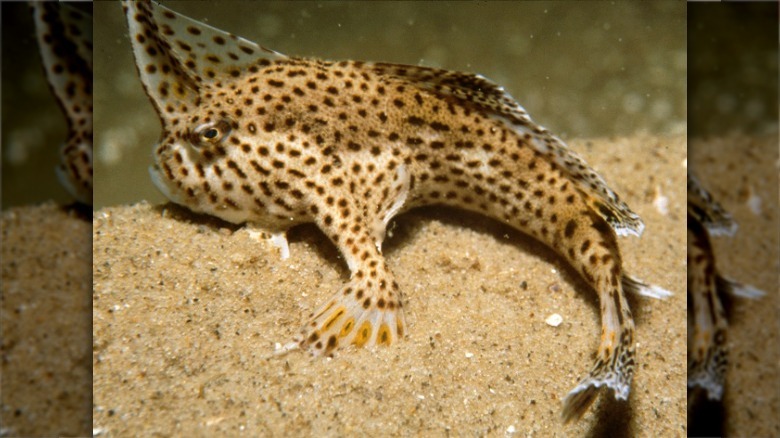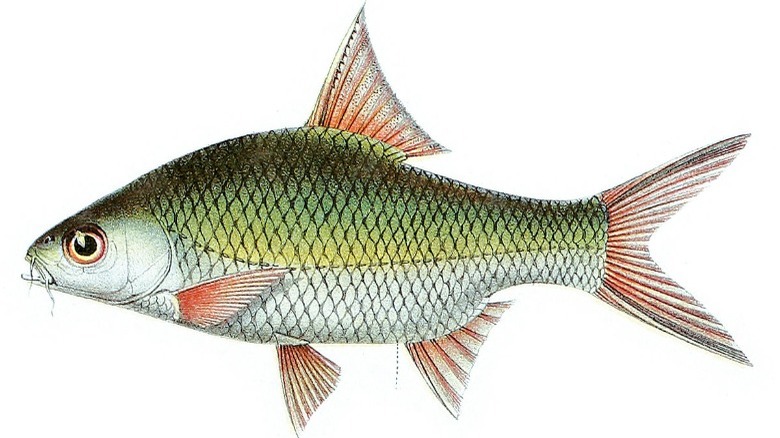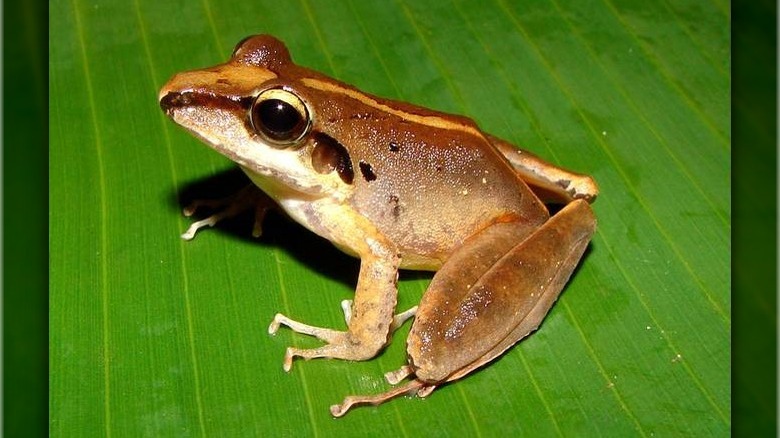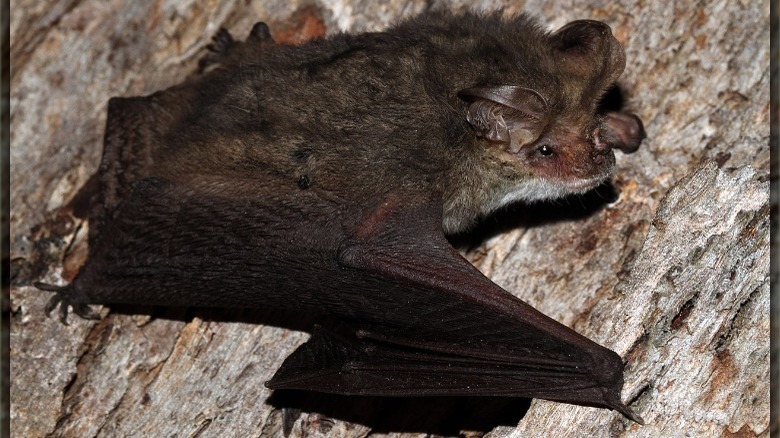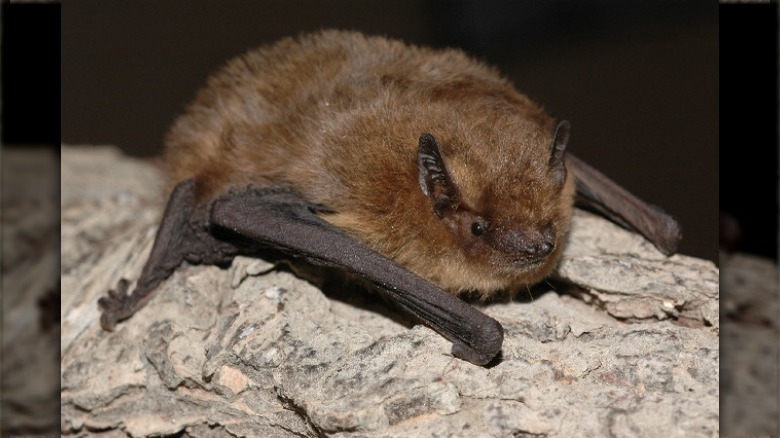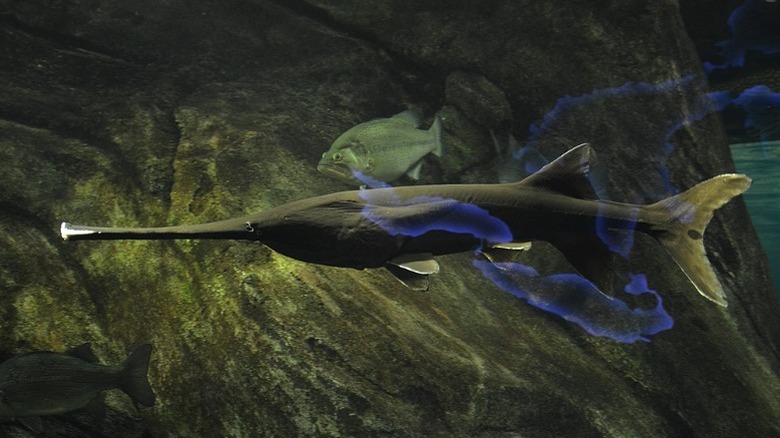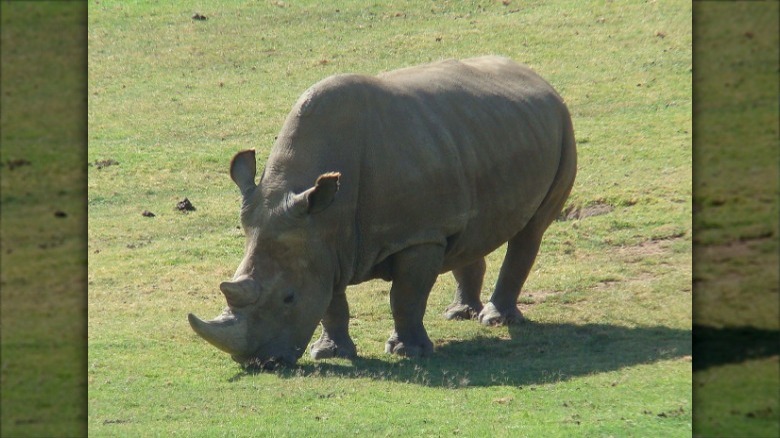Animals That Have Gone Extinct In The Past Decade
When you think about extinctions, the species that first come to mind might be those from long in the past. You know, woolly mammoths, saber-toothed tigers, dinosaurs in general — the usual suspects. Here's the thing though: extinction doesn't really work that way. It's not a thing that belongs only in the past. On the contrary, it's always been — and still remains — a problem, with multiple species being declared extinct each year.
That said, the actual practice of declaring a species extinct is a little sticky. As Scientific American says, in some cases, slapping the label of "extinct" onto a species can actually have a detrimental effect on conservation efforts. Even if the truth is that some members of an endangered species have still managed to survive, should the public at large think that said species is extinct, then any attempts at a revival could very easily dry up. And then, at that point, there would truly be no hope for species in that kind of situation. As such, many species that haven't been seen for years aren't labeled as extinct, just in case.
But even despite that, many species are still officially declared extinct every year, and in quite a disturbing number of cases, human intervention is at the heart of the issue, whether via direct or indirect means. So even though these species have been declared extinct within the past decade, their stories are ones best remembered.
Bramble cay melomys
Extinction as a result of human interference is something that everyone has heard about at one point or another, particularly down to climate change doing quite the number on the planet. But that concept is more than just a scary hypothetical — it's very real, in fact, and the first reported case of it happens to be the Bramble Cay melomys.
The Guardian explains that these cute little rodents were indigenous to the tiny island of Bramble Cay, near Papua New Guinea. Their full history is (and will now probably forever be) a mystery, but with the island sitting just barely above sea level, it was incredibly sensitive to changes in the ocean. Over time, the rising sea levels completely destroyed the melomys' natural environment until only a few hundred were left by 1978. A report 20 years later found just under 100, and by 2014, the population appeared to be entirely gone. A year later, not only was the species declared extinct, but even tissue samples kept for later study somehow disappeared.
An article from Pacific Conservation Biology directly blames climate change, but indirectly blames the priorities of conservation efforts. While most of the public knows about conservation as it relates to species like the giant panda, conservation groups didn't push the story of the Bramble Cay melomys because it wouldn't likely garner much support in comparison. Basically, the public just never knew this extinction was happening, so no efforts were made to reverse it, and the melomys was allowed to quietly slip away.
Po'ouli
You wouldn't necessarily expect an academic article published in the Wilson Bulletin called "Nesting Behavior of the Poo-uli" to be the bearer of a dark warning, but, well, scholarly papers aren't always dry recitations of information. In fact, it starts out by explicitly saying that the Po'ouli was dangerously close to extinction back in 1996, and then it even gives the actual reason behind the study: an attempt to record information on the tiny Hawaiian bird before it was too late.
See, according to The Guardian, the po'ouli lived in the rainforests of Maui, where they liked to forage on the forest floor. Humans didn't even discover the species until 1973, and by then, the po'ouli population was estimated at only 200. As for why? Well, one of the most likely explanations is the introduction of invasive species as a result of human settlements. Pigs, rats, cats, and other animals competed with the po'ouli for food, or else preyed on the birds themselves; new mosquitoes also carried diseases which proved deadly for the birds.
By the 1990s, officials were aware of the problem, but conservation efforts were lacking, to say the least, with the po'ouli population falling to just three by the turn of the century. In 2002, official conservation efforts were finally approved, but nothing could really be done. Attempts to encourage a pair of po'ouli into mating were unsuccessful, and the last known member of the species died in 2004, with the IUCN officially declaring them extinct in 2019.
Chiriqui Harlequin frog
If you'd ever seen the Chiriqui Harlequin frog, it would've likely proven to be pretty memorable. After all, as The Guardian explains, not only was the frog vibrantly colorful — and thus rather toxic — but it also had some quirky little mannerisms. For one, they were known to wave at each other to attract the attention of potential mates, and that could sometimes lead to their other specific ritual – the male jumping onto and hugging the back of the female.
The frogs were rather free to wave and ride each other in the streams of Costa Rica and Panama for a long time (via IUCN Red List), but, all of a sudden, their fortunes began to turn — and seemingly out of the blue. Prior to the mid-1990s, the frogs were incredibly abundant, but after that point, they (and other frog species in Central America) suddenly began to disappear from both nature reserves and the wilderness. By 1996, the last Chiriqui Harlequin frog was seen, and throughout the 2000s the IUCN Red List listed the species as critically endangered, before officially naming it as extinct in 2020.
Just what happened to change things so quickly, though? These kinds of frogs prefer environments that also happen to be conducive to fungal growth; it just so happened that a fungus originating from Asia found its way to Central America. This fungus infected frogs through their skin, eventually leading to breathing problems and heart failure, bringing about devastating losses to amphibian populations.
Smooth handfish
Handfish are a pretty odd little species. If you take a look at photos of them, they're quite literally fish with hands. According to Live Science, they thrived just off the coast of Australia, where they would crawl along the seafloor, and were first sighted in the early 1800s. Back then, things were going well for them, but the fact they thrived so well in those waters might have been detrimental in the end.
See, those shallow and warm waters are a pretty specific environment, and the smooth handfish wasn't particularly adaptable to change; in fact, adults of the species liked to live very sedentary lives, only really moving around if actively scared off, per Scientific American. And on top of that, the specific way that these fish reproduce wasn't exactly conducive to spreading their population around a wider area.
So when humans entered the picture, well, it's not hard to imagine that things didn't exactly go well, and it seems that the usual suspects were at play. Pollution destroyed the native habitat, and it also brought invasive species into the same areas, depriving the handfish of their home. Overfishing also played a part, with a scallop fishery operating in the mid-20th century both directly killing handfish that were accidentally caught, and indirectly killing them by carving through the seafloors where they lived. By 2020, the smooth handfish hadn't been seen in well over a century, and it was officially declared extinct.
Lake Lanao freshwater fish
The Philippines are home to Lake Lanao, an ancient lake that has the extra cool fact that it has volcanic origins. Per Esquire, these two factors taken together mean that this lake was the perfect home for some pretty unique species of fish, 17 of which were members of the Barbodes species.
The Guardian explains that these fish have had a pretty long history with the Indigenous population, but around the mid-20th century a newly independent Philippines began to upgrade its fishing industry. And it did so by introducing a species like tilapia into Lake Lanao. These kinds of fish were great at being an accessible source of food for a bunch of people, but they were also invasive species, which often isn't great news for native types of animals. In short, the Barbodes species was dealing with new competition, but it seems likely that some other omnivorous fish managed to sneak their way into the lake at the same time. In other words, the barbodes not only had competition, they also had new and dangerous predators.
Over time, the poor planning and lack of caution led to the demise of many Barbodes fish, which were out-competed or hunted by invasive species introduced as a result of human intervention. By 2020, 15 of the 17 species originally native to Lake Lanao were declared extinct.
Craugastor myllomyllon
If you're reading this article, then there's a good chance you're the kind of person who loves answers. But the unfortunate truth is that sometimes, answers just don't really exist, and that's exactly the case when it comes to the Craugastor myllomyllon.
After all, according to the IUCN Red List, this little amphibian was so rare that it never even got a common name, hence the use of just fancy Latin nomenclature. And aside from that, its official IUCN page is really, really short, as only one live specimen was ever found — a single female found in central Guatemala back in 1978. From there, well, that's all that anyone really knows, though not necessarily for lack of trying. Researchers have led a number of expeditions into the area between 1998 and 2019, each time trying to find more members of this elusive species, but always to no avail.
As such, that August 2019 assessment led to the announcement in 2020 that the Craugastor myllomyllon was officially extinct, though, rather fittingly, the reason behind the extinction is mostly a guess. Researchers assume agricultural development to be the culprit, destroying the amphibian's native habitat, but that's mostly just because the area it likely inhabited is now vast farmland.
Lord Howe long-eared bat
Now, here's a bit of a strange tale. The IUCN Red List assessed the Lord Howe long-eared bat in 2019 and officially declared it extinct in 2020, but to be entirely accurate, there's never been a confirmed sighting of a live member of the species. It's definitely an odd case, to say the least.
There's almost nothing known about this bat — the species' IUCN page is mostly empty, except where it specifies that information is scarce — and its mere existence as a species is mostly based on a single, fractured skull found on Lord Howe Island in Australia. According to The Conversation, the story goes that a group of explorers back in the 1880s reportedly saw two different-sized bats while on an expedition to Lord Howe Island. Given that they didn't capture either of the bats, the existence of the larger bat couldn't be confirmed — at least until 1972, when a skull matching the general description of the Lord Howe long-eared bat was found in an owl roost located in a cave. And that's all that's really known for certain regarding the species' life and eventual demise.
It's true that human settlers on the island did harm the populations of other local species, so it's a decent guess that people had something to do with the bat's extinction. More specifically, the introduction of invasive species — specifically predators — might have been at fault, but realistically, there's just not enough information to draw definite conclusions.
Christmas Island pipistrelle
According to The Nature Conservatory, bat species in North America haven't been doing too great as of late, with more than half of them being either critically endangered or outright extinct. Obviously, that doesn't bode well for bats living in the U.S. and Canada, but that doesn't mean that their cousins in the southern hemisphere are entirely free from trouble, either.
Take the Christmas Island Pipistrelle. A paper published in Conservation Letters says that the tiny bat native to Christmas Island was once abundant. But as the end of the 20th century approached, those numbers began to decline; by the turn of the century, the falling numbers were concerning enough for conservationists to keep a close eye on the species. The Australian government was urged on multiple occasions over multiple years to take action — perhaps even drastic action — to try and save the bats. But every plea for official conservation efforts was met with stalling. A plan for capturing the last remaining members of the species wasn't approved until January 2009 — and put into effect in July that same year — but by then, it was too little, too late. August 26, 2009, was the last time a Christmas Island pipistrelle was ever detected in the wild.
Officially, though, the species wasn't named as extinct until 2017 (via New Scientist), and the exact cause is still unknown. Most guesses name invasive species and disease as the lead suspects, though really, bureaucratic red tape had a hand in allowing the Christmas Island pipistrelle to disappear entirely.
Chinese paddlefish
Ancient animals like the Chinese paddlefish are (or, in this case, were) really quite fascinating. Just think about it: In this particular case, this is a fish that's been around on Earth for over 200 million years (via National Geographic). It was swimming around in rivers alongside the dinosaurs; for that matter, it even survived the catastrophe that killed the dinosaurs. That's a pretty unique claim to fame, which is almost fitting to how the paddlefish lived their lives: Coming in at over 20 feet in length and nearly 1,000 pounds in weight, they dug their long noses through the bottoms of rivers, finding prey by detecting electrical signals (via Smithsonian Magazine). Cool, right?
Unfortunately, though, while the Chinese paddlefish could survive a literal meteor strike, it couldn't survive human intervention. Overfishing severely threatened paddlefish populations back in the 1970s, but even official protection by the Chinese government didn't solve the problems. Sure, overfishing wasn't allowed, but a dam was still built right in the middle of the paddlefish's home, splitting up the population and disrupting their routines. In the end, the species just wasn't able to bounce back: Attempts to capture the species were unsuccessful, and the last Chinese paddlefish was spotted in 2003.
Researchers suspect that the species went extinct sometime between 2005 and 2010. That said, it would take another decade for the official verdict to be passed; according to Reuters, the IUCN officially declared the species extinct in 2022.
Northern white rhinoceros
To be entirely accurate, the Northern white rhinoceros isn't fully extinct. That said, it's still functionally extinct; according to Smithsonian Magazine, the last male of the species, named Sudan, died back in 2018. On its own, that would already spell a pretty poor fate, but on top of that, there are only two female members of the species left, both of whom are too old to have any offspring. This makes it accurate to call these rhinos functionally extinct, a fate they met largely due to rampant poaching by hunters who wanted nothing more than their horns (via World Wildlife Fund).
But it should be mentioned that science really is quite the fantastical thing. As explained by The Guardian, there's a chance that the Northern white rhino could be brought back from its state of effective extinction. Sperm and egg samples from over a dozen different rhinos have been saved and preserved, so in theory, a viable embryo could be created in a lab and inserted in a surrogate. Even without a living male and female pair, a new Northern white rhino could potentially be born. Granted, this is still theoretical, as it hasn't been done successfully yet (and the process itself raises some strange ethical questions about effectively raising any extinct species from the dead), but researchers think that technology will be up to the challenge within the next decade.
